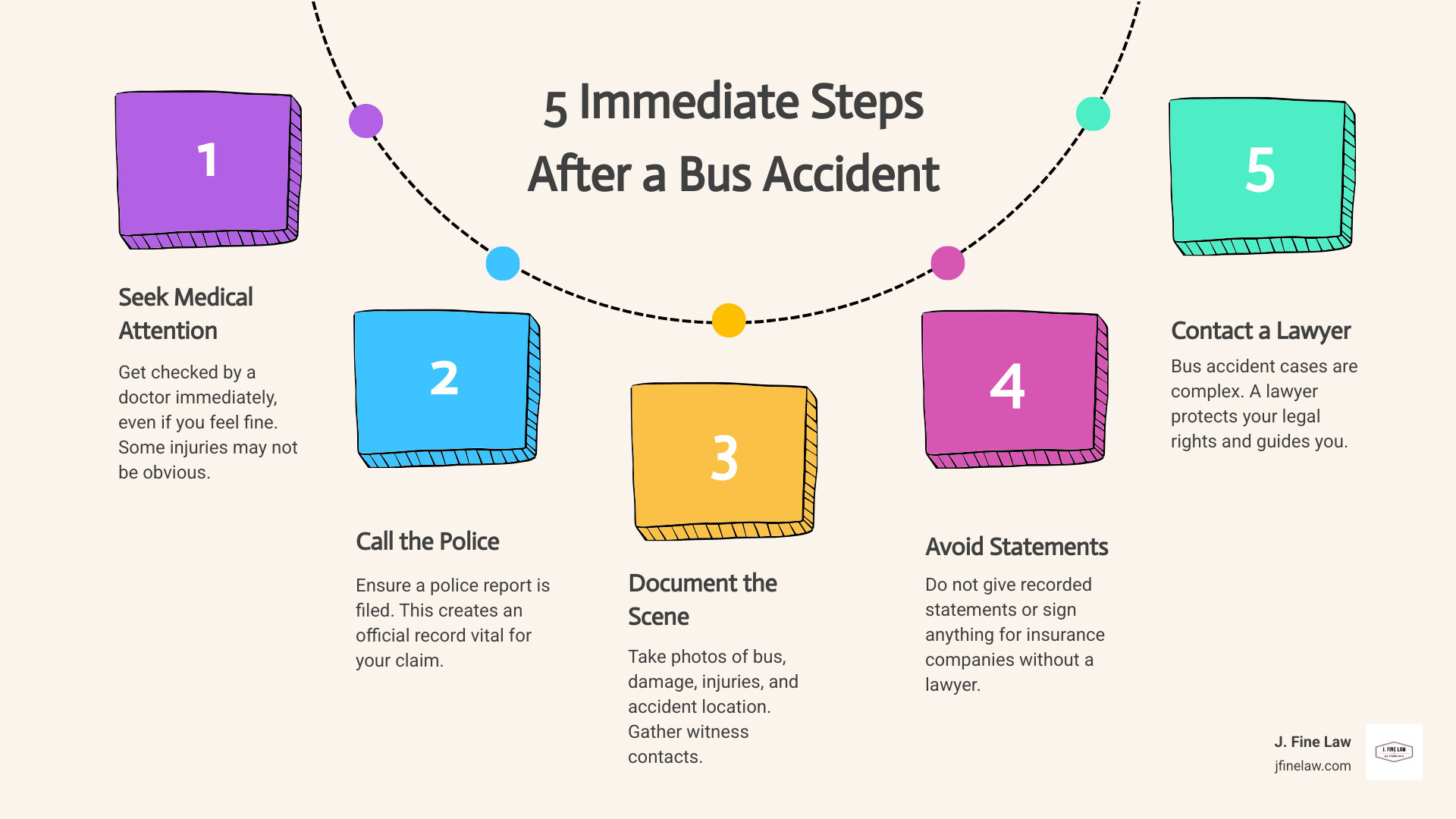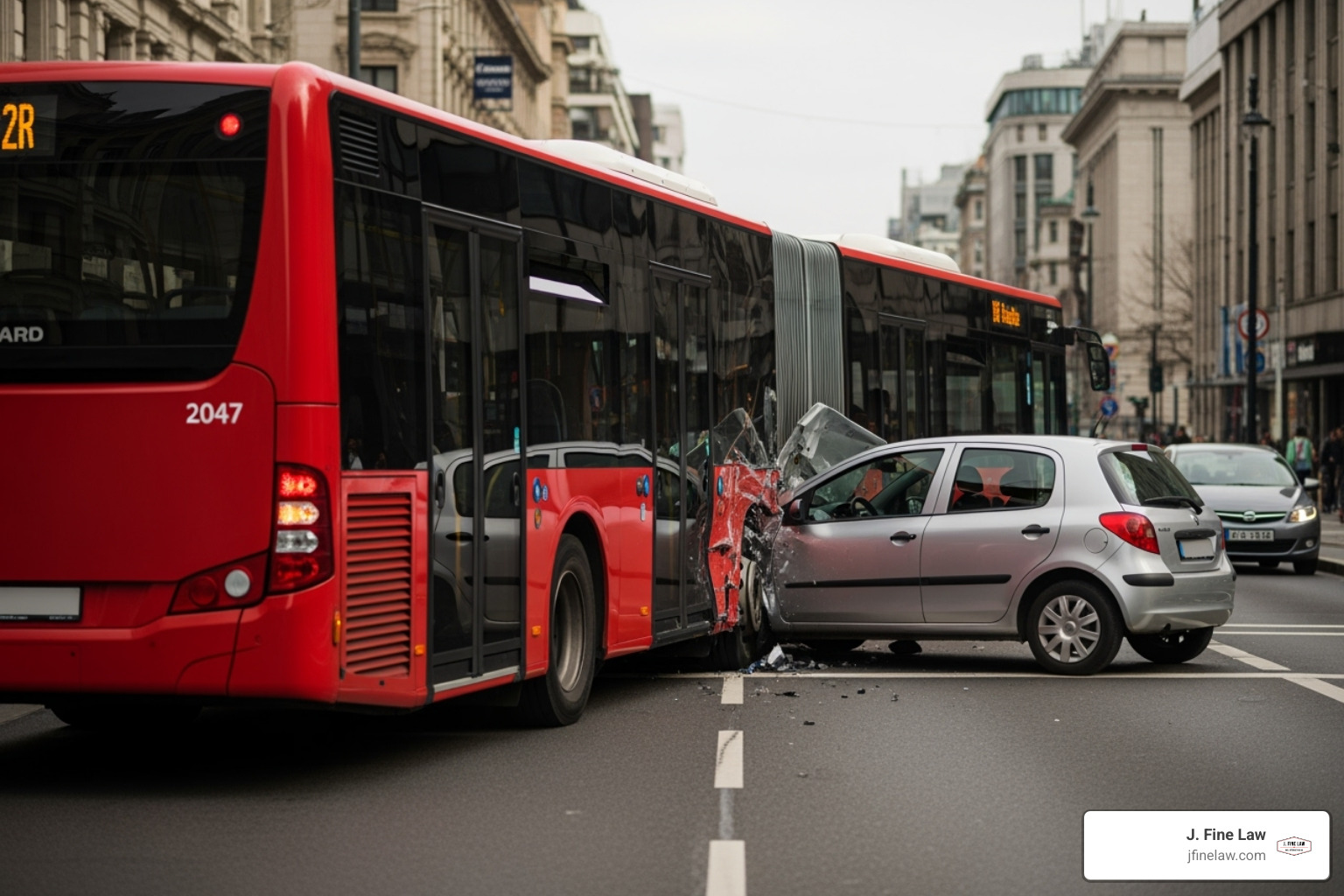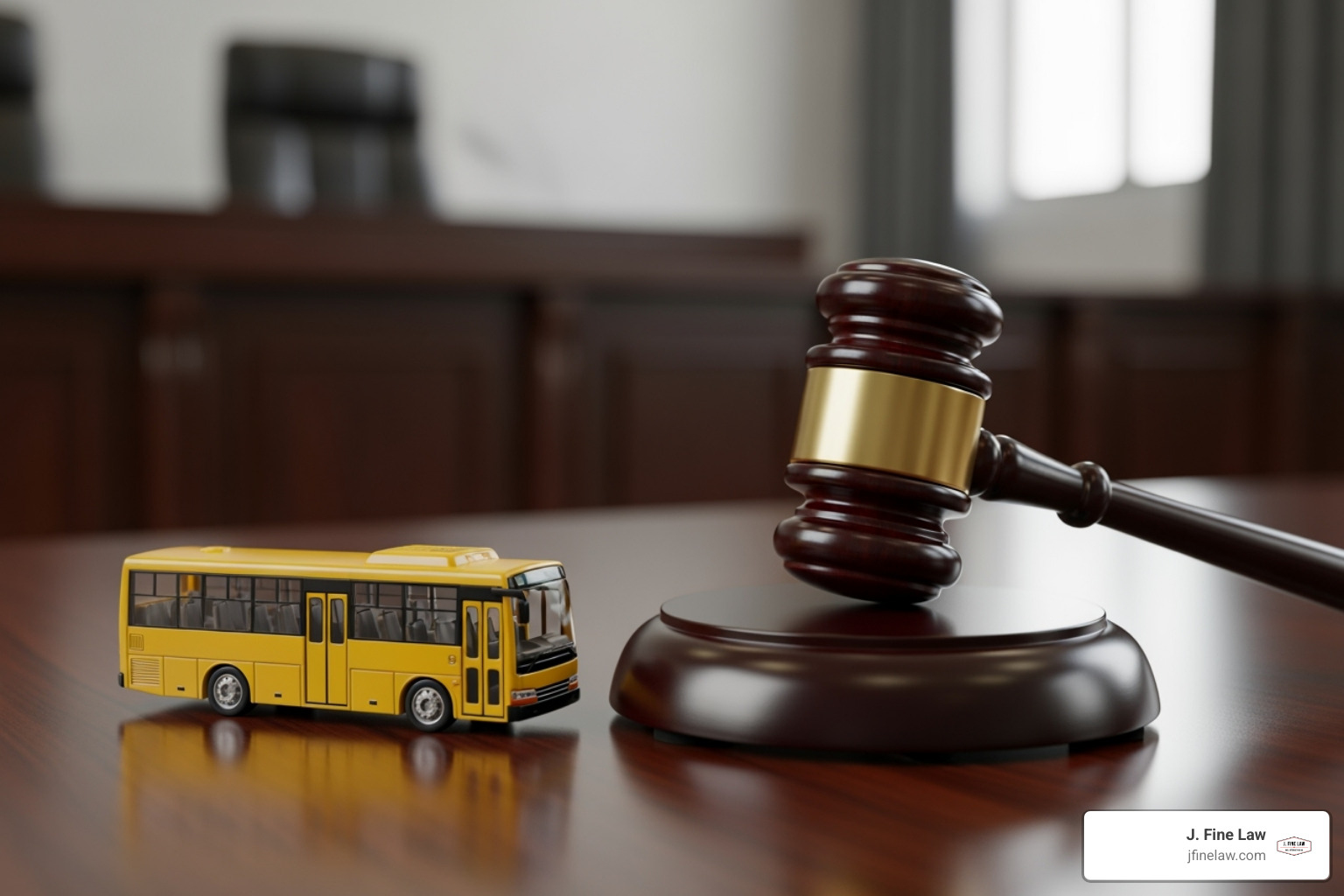Understanding Your Rights After a Bus Accident
If you or a loved one have been injured in a bus accident, you likely feel overwhelmed and uncertain about what to do next. Bus accidents can be particularly frightening due to their sheer size and the potential for serious injuries.
When an accident happens, know the immediate steps to protect your health and your legal rights.
Here are the crucial first actions to take:
- Seek Medical Attention: Get checked by a doctor, even if you feel fine. Some injuries aren’t immediately obvious.
- Call the Police: A police report creates an official record of the accident, which is vital for any claim.
- Document the Scene: Take photos of the bus, the accident location, any damage, and your visible injuries. Get contact information from witnesses.
- Avoid Statements: Do not give recorded statements to insurance companies or sign anything without speaking to a lawyer.
- Contact a Lawyer: Bus accident cases are complex, involving special laws and powerful insurance companies.
Navigating the aftermath of a bus accident can feel like an uphill battle, especially when facing medical bills and dealing with uncooperative insurance companies. This guide will walk you through everything you need to know, from immediate steps at the scene to understanding your compensation rights.
I’m Jason Fine, and for over 25 years, I’ve dedicated my career to representing victims who were injured in a bus accident and other motor vehicle incidents. My goal is to help you steer this complex process and fight for the justice you deserve.
Common injured in bus accident vocab:
What to Do Immediately After a Bus Accident: A Step-by-Step Guide
A crash scene can feel chaotic, but a few clear actions protect both your health and any future claim.
1. Put Your Health First
- Call 911 so police and paramedics arrive.
- Let medical professionals examine you, even if you feel okay. Concussions, internal bleeding and spinal injuries often hide at first.
- Follow all doctor instructions and keep every record. Consistent treatment creates the paper trail that ties your injuries to the crash. For details on how medical records affect payouts, see our guide to personal injury settlements.
2. Secure Key Evidence (if you can do so safely)
- Ask the officer for the police report number and the officer’s name.
- Photograph the buses, any other vehicles, road conditions, traffic signals and your visible injuries.
- Get the bus company name, bus number, driver’s name/ID and license plate.
- Collect contact information from witnesses (passengers or bystanders).
- Do not apologize, admit fault or give a recorded statement to an insurer.
- Start a file for receipts, medical bills and lost-wage statements.
If you’re unable to gather all of this at the scene, don’t worry. We can help track it down later. You can also ask the driver for that information, but never argue or put yourself in danger.
Taking these two simple steps—prompt medical care and early evidence collection—lays the foundation for a strong claim and a faster recovery.
Understanding Bus Accidents: Common Causes and Severe Injuries
Buses move thousands of riders across Pennsylvania and New Jersey every day. Their size and lack of seatbelts, however, mean even a low-speed collision can cause devastating harm.
Common Causes of Crashes
- Driver error (speeding, distraction, fatigue, DUI, aggressive maneuvers)
- Poor maintenance (worn brakes, bald tires, defective steering)
- Inadequate hiring or training of drivers
- Bad weather or road hazards
- Other negligent motorists cutting off or striking the bus
More detail on operator negligence is in our article on bus driver negligence.
Typical Injuries We See
Because passengers are often unrestrained, injuries can be severe:
- Cuts, bruises and deep lacerations
- Broken bones and complex fractures
- Internal bleeding or organ damage
- Head and neck trauma, from whiplash to traumatic brain injury
- Back or spinal-cord damage that may cause partial or complete paralysis
- Facial fractures and eye injuries
- Emotional injuries such as PTSD, anxiety or depression
Recognizing the full range of potential harm helps us calculate the real cost of an accident—treatment today and care you may need for years to come.
Who Can Be Held Liable for Your Injuries?
When you’ve been injured in a bus accident, figuring out who’s responsible can feel like untangling a complex knot. It’s often much more involved than a regular car crash. That’s because multiple parties can be held accountable, and bus companies – especially public ones – operate under a very specific set of rules and legal duties.
Buses, whether they’re public transit or private charters, are considered “common carriers.” What does that mean for you? It means they have a very high duty to be careful and transport passengers safely. Imagine they’re promising to get you from point A to point B with the utmost care. In places like Pennsylvania and New Jersey, this means they owe you a “highest duty of care.” So, even a slight bit of negligence on their part can be enough to establish a claim. Plus, a bus company is often held responsible for the actions of its employees, like drivers. This is called “vicarious liability,” and it makes bus accident cases quite unique.
Potentially Responsible Parties
When you’ve been injured in a bus accident, identifying all the potentially responsible parties is a crucial step toward securing the compensation you deserve. While the bus driver might seem like the obvious party if their actions (like distracted driving, speeding, or fatigue) caused the crash, the picture is usually bigger.
The bus company or owner can also be held responsible, not just for their driver’s actions, but also for their own negligence in areas like hiring, training, supervising drivers, or failing to properly maintain their fleet. If the bus is part of a municipal or state-run system, like SEPTA in Philadelphia, then the public transit authority might be liable. These cases have their own unique challenges, and we have dedicated resources to explain more about local transit accidents. Similarly, if a school district bus or a private tour or charter company was involved, they could be held accountable.
Sometimes, the problem isn’t the driver or the company, but a faulty component. In such cases, the vehicle manufacturer could be at fault if a defective part or design flaw contributed to the accident. Or perhaps an outside maintenance or repair company didn’t do their job correctly, leading to a mechanical failure. And let’s not forget, another negligent driver on the road might have caused or contributed to the bus accident, making them and their insurance company responsible. In rare situations, a government agency responsible for roads could even be partially liable if extremely dangerous road conditions directly led to the crash. As you can see, it’s a lot to consider, and uncovering all responsible parties is key.
Special Rules for Government-Owned Buses
Now, if your bus accident involved a government-owned bus – like those operated by a city or state transit system – things get even more specific. This is where legal doctrines like “sovereign immunity” come into play. Basically, these protect government bodies from lawsuits unless certain very specific conditions are met.
In Pennsylvania, the Pennsylvania Tort Claims Act outlines the limited situations where you can sue a government entity. New Jersey has a similar law, the New Jersey Tort Claims Act, which governs claims against public entities there. The most important thing to know about these laws? Time is of the essence!
While the general statute of limitations for personal injury claims in Pennsylvania and New Jersey is typically two years, if a government entity is involved, you often have a much, much shorter window – sometimes as little as six months – just to file a formal “notice of claim.” Missing this crucial deadline, even by a day, can mean you lose your right to sue entirely, regardless of how strong your case is. Plus, there are very strict procedural requirements and specific forms you must follow precisely. Any deviation can lead to your case being dismissed.
Because of these complex rules and tight deadlines, timely legal action is incredibly important. If you’ve been injured in a bus accident involving a government-owned bus, it’s absolutely critical to contact an attorney immediately. We have extensive experience navigating the intricacies of these laws in both Pennsylvania and New Jersey. For more specific information about mass transit accidents in New Jersey, we invite you to visit our dedicated page.
Filing a Claim When You’re Injured in a Bus Accident
A successful injury claim shows four things: the at-fault party owed you a duty of care, breached that duty, caused the crash and, as a result, you suffered damages. Our team handles the paperwork, negotiations and, when needed, litigation so you can focus on healing.
What Compensation Can You Recover?
Damages fall into two broad categories:
- Economic – medical bills (past and future), lost wages, reduced future earnings, rehabilitation and long-term care costs.
- Non-economic – pain, suffering, emotional distress, loss of enjoyment of life and, in rare cases, punitive damages.
The value of these elements depends on injury severity, proof of liability and insurance limits. We fight to make sure nothing is overlooked.
Key Deadlines
- Private bus or third-party driver: generally 2 years from the accident date in PA and NJ.
- Government-run bus (for example, SEPTA): you may have as little as 6 months to file a formal notice of claim before suit. Miss it and the case can be barred.
Building Your Case
Evidence we assemble often includes police and medical records, surveillance or dash-cam video, witness statements, maintenance logs, driver history and expert accident reconstruction. The sooner you call, the easier it is to secure this proof before it disappears.
Frequently Asked Questions about Bus Accident Claims
What if I was partly at fault?
Pennsylvania and New Jersey use modified comparative negligence. Your recovery is reduced by your own percentage of blame, but you can still collect so long as you are 50% or less responsible.
How much is a typical settlement?
There is no true “average.” Minor injuries may resolve for a few thousand dollars, while catastrophic cases can reach six or seven figures. Severity of injury, clarity of fault and available insurance drive value.
Do I really need a lawyer?
Bus claims involve multiple parties, tight government deadlines and large insurance carriers intent on paying as little as possible. An attorney levels the playing field, preserves evidence and pursues every dollar you deserve. We work on a contingency fee, so you owe nothing unless we win.
Conclusion: Take the Next Step to Protect Your Rights
After being injured in a bus accident, it’s completely normal to feel like your world has been shaken up. The physical pain, the emotional toll, those unexpected medical bills piling up, and even lost wages can feel incredibly overwhelming. It’s a lot to handle, and honestly, you shouldn’t have to face it all by yourself.
That’s why taking the immediate steps we’ve talked about – like making your health the absolute top priority, gathering details at the scene, and reaching out for expert legal advice – is so incredibly important. Especially with those tricky government-owned buses, time is truly of the essence. Acting fast is your best bet for protecting your future and your rights.
Here at J. Fine Law, we genuinely get how complex bus accident claims can be, whether you’re in Pennsylvania or New Jersey. Our dedicated team is all about being there for you, fast. We pride ourselves on a rapid attorney response, meaning you’ll have experienced legal advocates right by your side from the very start. We’re proud of our 98% success rate and the over $50 million we’ve recovered in settlements for folks just like you. Plus, with our no-fee promise, you won’t pay us a dime unless we win your case. That’s peace of mind, right there.
Think of us as your navigators through this challenging time. We’re here to fight hard for your rights and help you secure the compensation you truly deserve. Don’t let the confusing legal stuff stop you from seeking justice. Pick up the phone and contact our Pennsylvania bus accident lawyers today for a free, no-obligation consultation. Let’s chat about your situation and see how our experience can work wonders for you. You’ve got nothing to lose but your worries.




